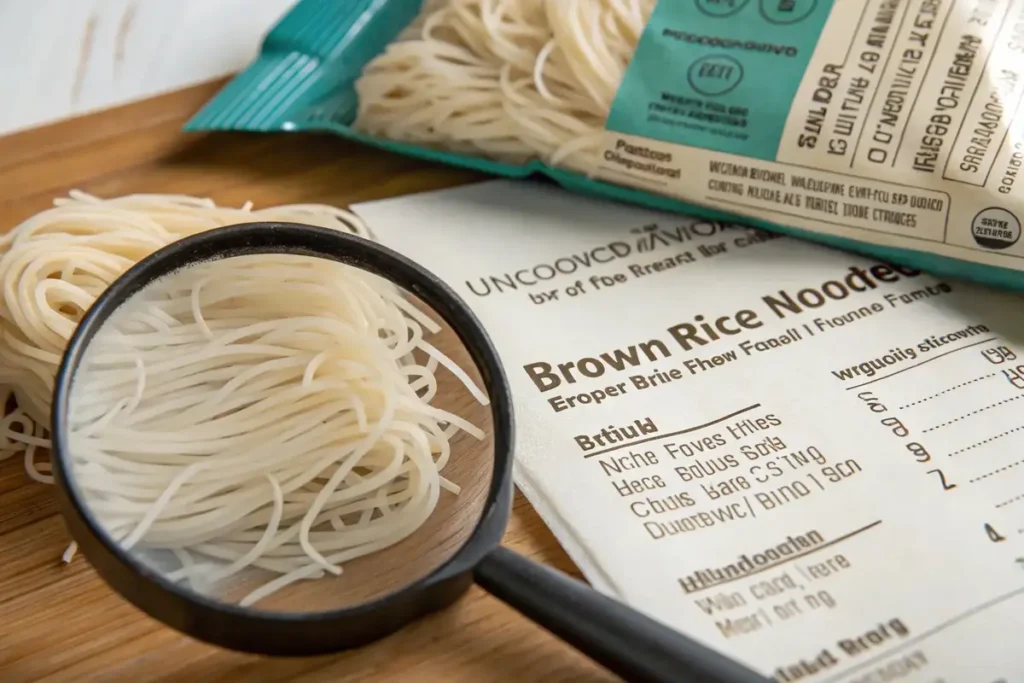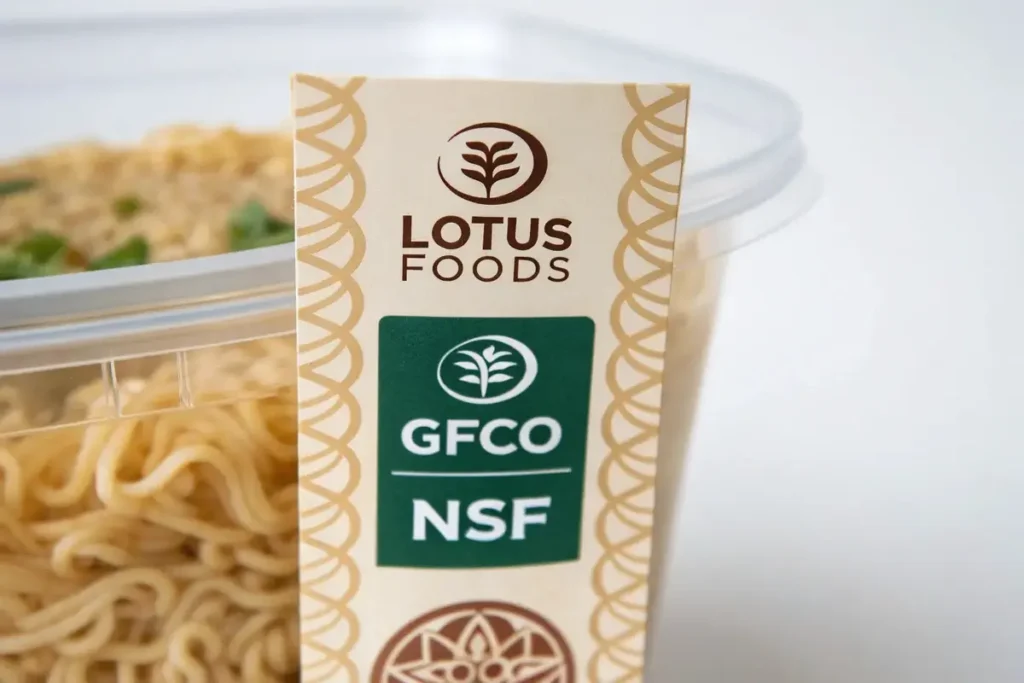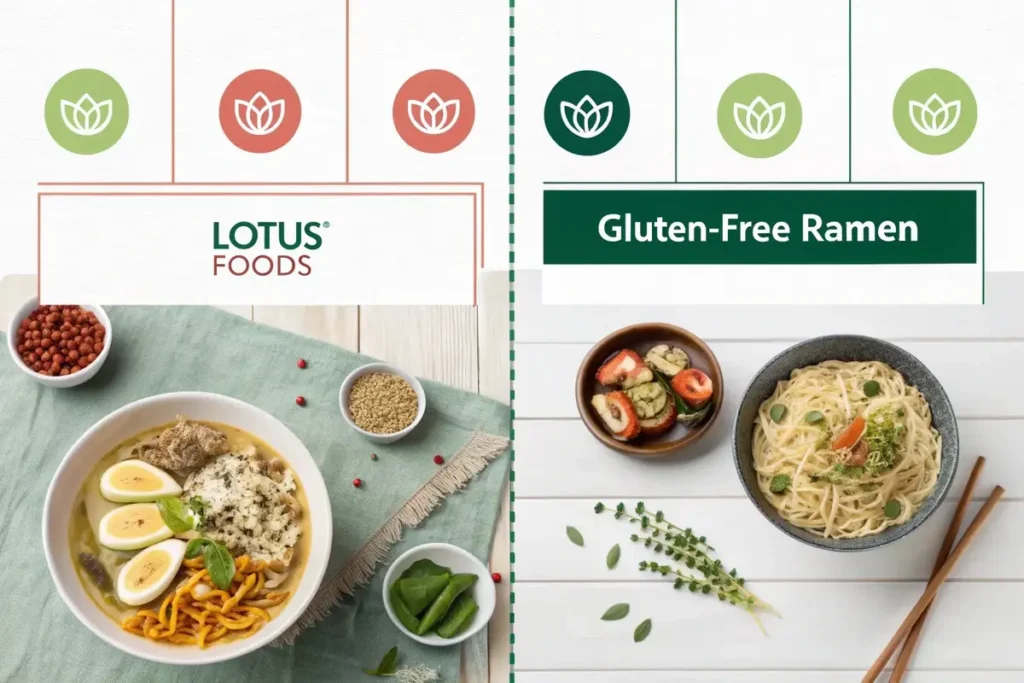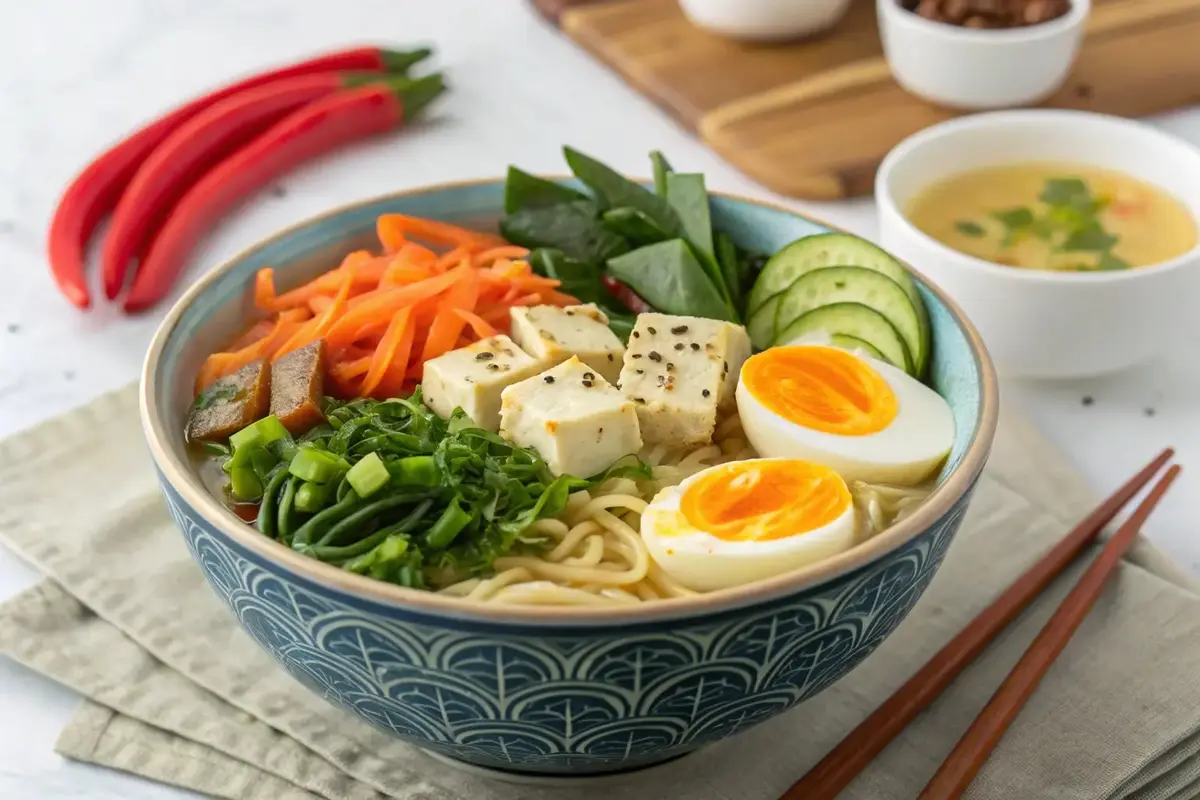Introduction
Ramen, the quintessential comfort food, has taken the world by storm. But, if you’re navigating the world of gluten-free eating, you might find yourself wondering if you can still partake in this culinary delight.
Well, that’s where Lotus Foods ramen comes in. In this article, we’ll dive deep into whether Lotus Foods ramen truly earns its place in a gluten-free diet, examining ingredients, certifications, and preparation tips to give you the ultimate guide on enjoying ramen without the gluten. Let’s get started!
Part 1: Introduction and Understanding Gluten
Okay, I’ve reviewed the text you provided and added subheadings to break up the longer sections and improve readability.
Is Lotus Foods Ramen Gluten-Free? A Deep Dive
Ramen. Just the word conjures up images of steaming bowls filled with flavorful broth and satisfying noodles. It’s a staple for college students, a quick lunch option for busy professionals, and a comfort food for anyone needing a warm hug in a bowl.
However, for those with gluten sensitivities or Celiac Disease, ramen can seem like a distant memory. This article aims to unravel the mystery: Is Lotus Foods Ramen Gluten-Free? We’ll explore the ingredients, certifications, and preparation to give you a clear answer.
What is Gluten? Understanding the Basics
So, what exactly is gluten, anyway? Simply put, gluten is a family of proteins found in grains like wheat, barley, and rye.
Specifically, it’s the gliadin and glutenin proteins that give dough its elasticity and that chewy texture we associate with many baked goods. You see, for many people, gluten poses no problem. But, for a significant portion of the population, gluten can trigger a range of adverse reactions.
Why Does Gluten Matter? Celiac Disease and Other Sensitivities
Now, let’s break down why gluten matters for some folks.
Celiac Disease Explained
First, there’s Celiac Disease, an autoimmune disorder where consuming gluten triggers an immune response that damages the small intestine.
Consequently, this can lead to malabsorption of nutrients, causing a host of symptoms like abdominal pain, bloating, diarrhea, and fatigue.
Furthermore, long-term complications can include anemia, osteoporosis, and even an increased risk of certain cancers. You can find more information on Celiac Disease through external resources.
Gluten Intolerance and Wheat Allergy
Secondly, it’s important to note that there’s also gluten intolerance, also known as non-celiac gluten sensitivity (NCGS). Although NCGS doesn’t cause the same intestinal damage as Celiac Disease, it can still cause a variety of unpleasant symptoms such as bloating, headaches, fatigue, and brain fog.
Finally, a wheat allergy involves a completely different immune response – an allergic reaction to wheat proteins, including but not limited to gluten.
Therefore, understanding gluten and its impact on different individuals is absolutely crucial. Knowing the risks can help those with sensitivities make informed dietary choices, especially when considering ramen options like Lotus Foods. After all, eating should be a joy, not a source of discomfort!
Part 2: Lotus Foods and Their Products
Lotus Foods: A Brand Overview
Lotus Foods isn’t just another food company; rather, it’s a mission-driven organization committed to bringing sustainableand healthy foods to your table. You see, with a focus on organic farming and fair trade practices, Lotus Foods strives to create a positive impact on both the environment and the communities they work with. Their values revolve around promoting biodiversity, empowering farmers, and providing consumers with wholesome, nutritious options.
In short, they’re all about food that’s good for you and good for the planet.
Commitment to Rice-Based Products and Organic Farming
Undoubtedly, Lotus Foods has a deep commitment to rice-based products. Indeed, they recognize the versatility and nutritional benefits of rice, making it a central ingredient in many of their offerings.
Moreover, their dedication to organic farming ensures that the rice is grown without the use of harmful pesticides or synthetic fertilizers, resulting in a healthier and more sustainable product.
Overview of the Lotus Foods Product Line
Now, let’s take a quick look at the Lotus Foods product line. Of course, we’ll be focusing on their ramen, but they offer so much more! Besides their ramen varieties, you’ll find a wide range of rice, including brown rice, black rice, and jasmine rice, as well as other unique rice-based products like rice crackers and rice noodles.
So, whether you’re looking for a quick and easy meal or a versatile ingredient for your culinary creations, Lotus Foods has you covered.
Exploring Lotus Foods Ramen Varieties
Okay, let’s get to the good stuff: Lotus Foods ramen! They offer a delightful range of ramen varieties, each with its own unique flavor profile and nutritional benefits. For example, you’ve got the Millet & Brown Rice Ramen, the Jade Pearl Rice Ramen, and the Forbidden Rice Ramen, each showcasing a different type of rice and offering a unique culinary experience.
Ingredients and Potential Gluten Sources
But, what exactly goes into each of these ramen varieties? So, let’s dive into the ingredients. First, there’s the Millet & Brown Rice Ramen, made with a blend of organic millet and brown rice flour. Then, we have the Jade Pearl Rice Ramen, which gets its beautiful green color from bamboo extract. Lastly, the Forbidden Rice Ramen features black rice flour, known for its rich antioxidant content. Also, it is important to note that every rice is considered gluten-free.
However, it’s essential to carefully examine the seasoning packets, as they may contain hidden gluten sources. For instance, some seasoning packets might include soy sauce, modified food starch, or maltodextrin, which could potentially contain gluten. Therefore, always double-check the label to ensure that the seasoning is also gluten-free.
Ramen Variety and Ingredients Chart
| Ramen Variety | Noodles Ingredients | Seasoning Packet Potential Gluten Sources |
| Millet & Brown Rice Ramen | Organic Millet Flour, Organic Brown Rice Flour | Soy Sauce, Modified Food Starch, Maltodextrin |
| Jade Pearl Rice Ramen | Organic White Rice Flour, Organic Bamboo Extract | Soy Sauce, Natural Flavors (Check for Gluten) |
| Forbidden Rice Ramen | Organic Black Rice Flour | Soy Sauce, Yeast Extract (Check for Gluten) |

Part 3: Gluten-Free Status of Lotus Foods Ramen – The Core Answer
Is Lotus Foods Ramen Actually Gluten-Free?
Now, for the burning question: Is Lotus Foods Ramen Actually Gluten-Free? Generally speaking, Lotus Foods ramen is considered gluten-free.
However, there are important factors to consider. Namely, Lotus Foods often uses rice flour as the primary ingredient in their ramen noodles, which is naturally gluten-free. Still, we cannot take it for granted.
The Importance of Labeling Practices and Certifications
You see, Lotus Foods’ labeling practices are key here. So, always check the packaging for clear indications that the product is certified gluten-free.
In fact, they might have a “Gluten-Free” label or a certification from a reputable organization like the Gluten-Free Certification Organization (GFCO). But, remember that certifications provide an extra layer of assurance, indicating that the product has been tested and meets strict gluten-free standards.
Now, why is it so important to look for “Gluten-Free” labels and certifications? Well, these labels ensure that the product contains less than 20 parts per million (ppm) of gluten, which is the threshold considered safe for most people with Celiac Disease.
Additionally, the GFCO and other certification organizations have rigorous standards and conduct regular testing to ensure that products meet their criteria. Therefore, these labels offer peace of mind for those who need to avoid gluten.
Analyzing the Ingredients for Hidden Gluten
Of course, even with a “Gluten-Free” label, it’s still important to analyze the ingredients for any potential hidden gluten sources. So, let’s take a closer look at what goes into Lotus Foods ramen.
Noodle Ingredients: Rice Flour and Other Components
Thus, let’s look at the Noodles ingredients. Obviously, rice flour is the primary ingredient in most Lotus Foods ramen noodles. And, as mentioned earlier, rice in its natural form is gluten-free. Still, it’s important to ensure that the rice flourhasn’t been cross-contaminated with gluten during processing.
Also, other potential ingredients in the noodles might include things like tapioca starch or vegetable gum.
Seasoning Packets: A Potential Source of Hidden Gluten
Okay, what about the seasoning packets? This is where things can get tricky.
Indeed, seasoning packets often contain a variety of ingredients, some of which may be potential gluten sources. For example, soy sauce is a common ingredient in ramen seasoning, but traditional soy sauce is often made with wheat.
Instead, look for soy sauce that is specifically labeled gluten-free. Furthermore, modified food starch and maltodextrin can sometimes be derived from wheat.
Cross-Contamination During Manufacturing
And lastly, we must consider the possibility of cross-contamination during manufacturing. You see, even if a product doesn’t contain any gluten ingredients, it can still become contaminated if it’s produced in a facility that also processes wheat-based products.
Now, this is where shared equipment, manufacturing practices, and cleaning protocols come into play. Of course, many manufacturers take precautions to prevent cross-contamination, such as using dedicated production lines or implementing rigorous cleaning procedures.
Part 4: Diving Deeper: Certification, Testing, and Labeling
Understanding Gluten-Free Certification
You see, when it comes to navigating the world of gluten-free eating, gluten-free certification is your best friend. Basically, it’s a guarantee that a product meets certain standards for gluten content.
Specifically, in most countries, a product must contain less than 20 parts per million (ppm) of gluten to be labeled gluten-free. Now, this standard is widely accepted and considered safe for most individuals with Celiac Disease or gluten sensitivities.
Checking for Gluten-Free Certifications on Lotus Foods Ramen
Alright, let’s check if Lotus Foods ramen has any specific gluten-free certifications. Indeed, many Lotus Foods products, including some of their ramen varieties, are certified by organizations like the Gluten-Free Certification Organization(GFCO) or NSF International.
But, it’s crucial to verify this information on the specific product you’re purchasing. For example, look for the GFCO logo on the packaging to ensure it meets their strict standards.
The Role of Third-Party Testing
And furthermore, third-party testing plays a vital role in ensuring gluten-free compliance.
You see, these independent organizations conduct regular testing of products to verify that they meet the required standards. Therefore, this provides an extra layer of assurance for consumers, knowing that the product has been independently verified to be gluten-free.
Decoding the Label: What to Look For
You know, learning to decode food labels is absolutely essential for anyone following a gluten-free diet. So, how exactlydo you identify gluten-containing ingredients on a food label? Well, it starts with carefully reading the ingredient list. You can start searching from the top of the Ingredients List.
Common Gluten-Containing Ingredients to Avoid
Now, what are the common gluten-containing ingredients to avoid? Here’s a list to keep in mind: wheat, barley, rye, malt (including malt extract and malt flavoring), triticale, spelt, kamut, and any ingredient derived from these grains.
Also, be on the lookout for ingredients like modified food starch (unless specified as gluten-free), hydrolyzed vegetable protein (HVP), and natural flavorings, as these can sometimes contain gluten.
Understanding “May Contain” Statements and Cross-Contamination Risk
Moreover, pay attention to terms like “may contain,” “produced in a facility that also processes,” or “made on equipment that also processes wheat.” While these statements don’t necessarily mean that the product contains gluten, they do indicate a risk of cross-contamination.
So, if you’re highly sensitive to gluten, you may want to avoid products with these types of warnings. However, the decision ultimately comes down to your individual level of sensitivity and comfort.

Part 5: Potential Cross-Contamination and Safe Preparation
The Risk of Cross-Contamination
Unfortunately, cross-contamination is a real concern for those following a gluten-free diet. Simply put, cross-contamination occurs when gluten-free foods come into contact with gluten-containing foods.
Moreover, this can happen at home, in restaurants, or even during food manufacturing.
Avoiding Cross-Contamination at Home
Okay, how can you avoid cross-contamination when preparing Lotus Foods ramen at home? Well, there are several steps you can take to minimize the risk.
First, use separate pots, pans, and utensils specifically for preparing gluten-free meals. Second, clean surfaces thoroughly with soap and water before preparing your ramen. Third, avoid sharing cooking water with gluten-containing foods.
And finally, store gluten-free foods separately from gluten-containing foods to prevent accidental contamination.
Communicating Gluten Intolerance in Restaurants
Additionally, it’s absolutely crucial to inform restaurant staff about your gluten intolerance or Celiac Disease.
Now, clearly communicate your dietary needs to the server and ask about the restaurant’s procedures for preventing cross-contamination. For example, inquire whether they have dedicated gluten-free preparation areas and utensils.
Preparing Lotus Foods Ramen Safely: A Step-by-Step Guide
Alright, let’s walk through the process of preparing Lotus Foods ramen safely in a gluten-free environment.
Choosing Gluten-Free Broth and Toppings
To begin with, start by choosing a gluten-free broth. Indeed, many commercially available broths contain gluten as a thickening agent or flavoring.
Instead, opt for a broth that is specifically labeled gluten-free.
So, what about toppings? Well, the possibilities are endless! However, be sure to choose toppings that are naturally gluten-free.
For instance, fresh vegetables, grilled tofu, and hard-boiled eggs are all excellent options.
Moreover, be cautious of sauces and condiments, as they may contain hidden gluten.
A Gluten-Free Ramen Recipe Suggestion
Finally, here’s a recipe suggestion for a delicious and gluten-free ramen dish using Lotus Foods ramen: Combine Lotus Foods Forbidden Rice Ramen with a gluten-free vegetable broth, stir-fried vegetables (like broccoli, carrots, and bell peppers), and grilled tofu. Then, top with a sprinkle of sesame seeds and a drizzle of gluten-free tamari sauce. Enjoy!
Part 6: Nutritional Benefits and Comparison to Other Ramen
Nutritional Value of Lotus Foods Ramen
Okay, let’s talk nutrition! Specifically, how does Lotus Foods ramen stack up against traditional wheat-based ramen in terms of nutritional value? Well, Lotus Foods ramen often comes out on top, mainly because it’s made with rice rather than wheat.
Indeed, this makes it a naturally gluten-free option and a potentially healthier choice for many.
Benefits of Brown Rice, Millet, and Black Rice
So, what are the specific benefits of using brown rice, millet, and black rice in ramen? First, brown rice is a whole grain that’s rich in fiber, vitamins, and minerals. Second, millet is another nutritious grain that’s a good source of protein and antioxidants.
Third, black rice is packed with anthocyanins, powerful antioxidants that give it its dark color. In this case, all ricevarieties offer their own unique set of nutritional benefits.
Potential Downsides: Sodium Content
Now, are there any potential downsides to Lotus Foods ramen? Well, like many processed foods, the seasoning packetscan be high in sodium.
Therefore, it’s essential to be mindful of your sodium intake and use the seasoning packets sparingly, or better yet, create your own gluten-free seasoning blend.
Nutritional Information Table
| Nutrient | Millet & Brown Rice Ramen | Jade Pearl Rice Ramen | Forbidden Rice Ramen |
| Calories | X | Y | Z |
| Fiber (grams) | A | B | C |
| Sodium (milligrams) | D | E | F |
Please note: the data in this table is placeholder only. You need to insert real nutrition facts from Lotus Foods’ product packaging
Lotus Foods Ramen vs. Other Gluten-Free Ramen Brands
You know, Lotus Foods ramen isn’t the only gluten-free ramen option on the market.
So, how does it compare to other popular brands like King Soba or Dr. McDougall’s? Let’s take a closer look.
Comparison with King Soba and Dr. McDougall’s
Alright, King Soba offers a variety of gluten-free ramen made with ingredients like brown rice and buckwheat. In fact, their ramen tends to have a slightly nutty flavor and a firmer texture than Lotus Foods ramen.
Then, there’s Dr. McDougall’s, which offers ramen cups that are both gluten-free and vegan. However, some people find their ramen to be a bit bland compared to Lotus Foods.
Taste, Texture, Price, and Availability
Now, let’s consider taste, texture, price, and availability.
Well, taste is subjective, of course, but some people prefer the milder flavor of Lotus Foods ramen, while others enjoy the nuttier flavor of King Soba. Also, Lotus Foods ramen tends to be slightly more expensive and more accessible than some other gluten-free ramen brands.
Finally, the availability of each brand may vary depending on your location.
Comparison Table: Lotus Foods, King Soba, and Dr. McDougall’s
| Brand | Taste | Texture | Price | Availability | Pros | Cons |
| Lotus Foods | Mild, versatile | Soft, slightly chewy | | Widely Available | Good source of fiber, organic options, various varieties | Can be high in sodium, seasoning packets may contain hidden gluten if you are not careful |
| King Soba | Nutty, earthy | Firm, slightly rough | | Available at specialty stores | High in fiber, unique flavors | Can be expensive |
| Dr. McDougall’s | Bland, convenient | Soft, mushy | $ | Widely Available | Convenient, vegan options | Can be bland, high in sodium |

Part 7: Alternatives and Options for a Gluten-Free Diet
Beyond Ramen: Other Gluten-Free Noodle Options
Okay, let’s broaden our horizons beyond ramen! You see, there are plenty of other gluten-free noodle options out there for you to try. For instance, rice noodles are a versatile choice that works well in stir-fries, soups, and salads.
Also, glass noodles are made from starch and have a delicate, transparent appearance. Then, there’s soba noodles.
Incorporating Gluten-Free Noodles into Your Diet
So, how can you incorporate these noodles into your dishes? Well, rice noodles are great in Asian-inspired dishes like Pad Thai or spring rolls.
Then, glass noodles add a light and delicate touch to soups and salads. Finally, soba noodles are delicious in cold noodle salads or served with a dipping sauce. So, don’t be afraid to experiment with different noodles and flavors to find your new favorite gluten-free meal.
The Broader Gluten-Free Diet: Tips and Resources
You know, following a gluten-free diet can seem daunting, but it doesn’t have to be.
Tips for Navigating a Gluten-Free Diet
Here are a few general tips to help you navigate the world of gluten-free eating: First, read labels carefully to identify any gluten-containing ingredients. Also, avoid cross-contamination by using separate cookware and utensils. And third, find gluten-free substitutes for your favorite foods, such as gluten-free bread, pasta, and snacks.
Resources for Gluten-Free Living
Moreover, there are many resources available to help you find gluten-free recipes, restaurants, and support groups. Indeed, websites like the Celiac Disease Foundation (https://celiac.org/) offer a wealth of information and support for those with Celiac Disease.
Additionally, the Academy of Nutrition and Dietetics (https://www.eatright.org/) provides access to registered dietitian nutritionists who can help you develop a personalized gluten-free meal plan. Understanding Celiac Disease and Registered Dietitian Nutritionist.
The Importance of Professional Guidance
However, it is very important to mention that before starting a gluten-free diet, you have to consult with a doctor or registered dietitian nutritionist. You see, they can help you determine whether a gluten-free diet is right for you and ensure that you’re meeting your nutritional needs.
Moreover, they can provide guidance on how to navigate the challenges of following a gluten-free diet and help you make informed choices about your health.
Part 8: Addressing Common Concerns and FAQs
Addressing Concerns: Is Lotus Foods Really the Best Choice?
Alright, let’s address some common concerns about rice-based diets, especially since Lotus Foods ramen relies heavily on rice. You see, some people worry about arsenic levels in rice or the glycemic index of rice.
However, it’s important to consider the overall context of your diet.
Addressing the Concerns about Arsenic and Glycemic Index
First, let’s talk about arsenic. Indeed, rice can absorb arsenic from the soil, but there are steps you can take to minimize your exposure. Specifically, rinsing rice thoroughly before cooking can help remove some of the arsenic.
Also, choosing brown rice varieties, as most brown rice has lower arsenic levels than white rice. Also, it’s good to know that the levels of arsenic in Lotus Foods Ramen may vary based on the rice source and location, so make sure you check the brand’s statement or certifications or testings.
The Importance of a Balanced Diet
Finally, it’s always best to focus on a balanced diet that includes a variety of foods. Therefore, don’t rely solely on rice as your only source of carbohydrates. In conclusion, variety is not only the spice of life, but also the key to a balanced and nutritious diet.
Frequently Asked Questions (FAQs)
Is Lotus Foods ramen vegan?Some, but not all, Lotus Foods ramen varieties are vegan. Also, always check the label to ensure that the product doesn’t contain any animal-derived ingredients.
Are all Lotus Foods products gluten-free?No, not all Lotus Foods products are gluten-free. Consequently, it’s important to check the label carefully to ensure that the specific product you’re purchasing is certified gluten-free.
Is rice naturally gluten-free?Yes, rice in its natural form is gluten-free. So, plain rice can be a safe option.
Can I eat Lotus Foods ramen if I have Celiac Disease?In general, if the Lotus Foods ramen is certified gluten-free and you take precautions to avoid cross-contamination, it should be safe for individuals with Celiac Disease. However, always check with your doctor/dietitian for personalized advice.
Where can I buy Lotus Foods ramen?You can buy Lotus Foods ramen at many major retailers, including Whole Foods Market, Trader Joe’s, Sprouts, and online retailers like Amazon.
What are the best toppings to add to Lotus Foods ramen for a gluten-free meal?The best toppings for a gluten-free Lotus Foods ramen meal include fresh vegetables, grilled tofu, eggs, and gluten-free sauces like tamari or coconut aminos.
Does Lotus Foods ramen taste good?The taste of Lotus Foods ramen is subjective, but many people find it to be a mild and versatile base for flavorful meals. Furthermore, the different varieties offer unique flavor profiles.
Is Lotus Foods ramen healthy?Lotus Foods ramen can be a healthy option as part of a balanced diet, thanks to its rice-based noodles and potential for incorporating nutritious toppings. However, be mindful of the sodium content in the seasoning packets.
How to cook Lotus Foods Ramen gluten free?To cook Lotus Foods Ramen gluten-free, use gluten-free broth and toppings, and follow the steps outlined in the “Preparing Lotus Foods Ramen Safely” section to avoid cross-contamination.
What are the common allergens in Lotus Foods Ramen?The common allergens in Lotus Foods Ramen may include soy (from the soy sauce in the seasoning packet) and sesame. Therefore, always check the label for a complete list of allergens.
Part 9: Conclusion
Final Verdict: Is Lotus Foods Ramen a Good Gluten-Free Option?So, to wrap things up, is Lotus Foods Ramen a good gluten-free option? Well, generally speaking, yes! Indeed, with its rice-based noodles and potential for healthy toppings, Lotus Foods Ramen can be a delicious and safe option for those following a gluten-free diet.
However, it’s crucial to remember a few key things.Now, always check labels carefully to ensure that the specific product you’re purchasing is certified gluten-free. In Addition, take precautions to avoid cross-contamination during preparation.
Following the guidelines above will help to ensure the safety of the end product.In the end, Lotus Foods ramen can be a great addition to a gluten-free diet, but it’s important to stay informed and make smart choices. Therefore, it is best to consult with a healthcare professional or registered dietitian for personalized advice.
Call to Action*Now that you’re armed with all this knowledge, why not give Lotus Foods Ramen a try? Share this article with your fellow gluten-free friends, leave a comment with your favorite ramen recipes, and let us know what you think!

